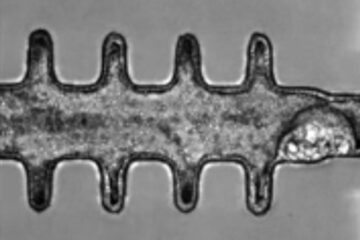Improving the Physics of Grocery Store Display Cases to Save Energy

Open-front refrigerated display cases, which make up roughly 60 percent of the refrigerated cases in grocery stores and supermarkets, provide quick access to chilled products such as dairy, meat, fish and produce. While they are popular with shoppers and grocery stores, they’re less popular with electric utilities and others concerned with energy efficiency.
Engineers at the University of Washington and Kettering University are working to cut the amount of energy used by these coolers, while enhancing product safety and quality. Results published this month in the journal Applied Thermal Engineering show that tweaking the physics can reduce the energy used for refrigeration by as much as 15 percent. Lead author of the article is Mazyar Amin, a former UW doctoral student now doing postdoctoral research at Missouri’s Saint Louis University.
Designing grocery display cases is not rocket science, but it has a lot in common with aeronautical engineering.
Refrigerated display cases shoot jets of air across their front openings, creating an invisible shield that aims to keep cold air in and warm air out.
Current technology does this with limited success.
“Most of the energy these cases use goes into cooling infiltrated air,” explains Dana Dabiri, a UW associate professor of aeronautics and astronautics. “Some energy goes to extract the heat from lighting and fan motors, some goes to remove the heat gain from radiation and conduction, but 75 percent of the cooling load is attributed to infiltration of warm and moist air from the surrounding environment.”
Open-air coolers are increasingly popular compared to other options. Refrigerated cases with doors are good at keeping cold air in, but they fog up when opened and can frustrate shoppers who want to look at more than one product while making a choice. Another design is to hang sheets of clear plastic in front of the opening, but some see this as tacky. Refrigerated bins that are open on top waste less energy because the cold air is heavier, and tends to stay inside the case. The big energy hog, and the focus of the UW research, are open-air vertical shelves.
The team includes principal investigator Homayun Navaz, a professor of mechanical engineering at Kettering who specializes in computational fluid dynamics and fluid flow simulations. Dabiri specializes in experimental work to measure and visualize fluid flows. Together they have directed five years of research in a cavernous lab on the Kettering campus in Flint, Mich.
There, researchers built a modular mock display case and an air curtain simulator to test various designs. They measured how much air was infiltrated for various air curtain speeds, angles, and other factors to minimize the amount of warm, moist air entering the chilled compartment of the case.
“One approach is to ask, ‘What are the optimal parameters so I can get the most efficient air curtain?’ and then start building those,” Dabiri said. “But instead of implementing costly redesigns for existing display cases, the question became, ‘What minimal changes can I do to improve the energy efficiency of the existing units?’”
The new paper establishes key variables that strongly affect the amount of warm air penetrating the air curtain. Results show that the most important factors are the angle between the case’s discharge and return air grilles, and jet’s exit Reynolds number, a figure that depends on the air speed and density, and the jet's turbulence intensity.
Combining experimental results and mathematical models, the team developed a tool that lets manufacturers optimize their particular design. Researchers collaborated with a leading display-case manufacturer to retrofit a proof-of-concept case. Tests showed the retrofit was a cost-effective way to get a 10 percent reduction in infiltration of warm air. (Calculations for other display designs show potential savings of up to 15 percent.)
Navaz’s team has now established a company in Flint, Michigan, that provides technical tools and training to help display-case manufacturers improve their products’ energy efficiency. “There’s definitely room for improvement in these display cases,” Dabiri said. “We’ve shown that we can get 10 to 15 percent improvement, which is definitely a tangible impact. In this whole push for energy efficiency, anything you can do is a help.”
An industry-wide implementation of the findings across the U.S. would save roughly $100 million in electricity costs each year.
Southern California Edison Co. funded the initial tests. Further research funding was from the U.S. Department of Energy, and the California Energy Commission’s Public Interest Energy Research program.
For more information, contact Dabiri at 206-543-6067 or dabiri@aa.washington.edu.
Media Contact
More Information:
http://www.washington.eduAll latest news from the category: Physics and Astronomy
This area deals with the fundamental laws and building blocks of nature and how they interact, the properties and the behavior of matter, and research into space and time and their structures.
innovations-report provides in-depth reports and articles on subjects such as astrophysics, laser technologies, nuclear, quantum, particle and solid-state physics, nanotechnologies, planetary research and findings (Mars, Venus) and developments related to the Hubble Telescope.
Newest articles

Solving the riddle of the sphingolipids in coronary artery disease
Weill Cornell Medicine investigators have uncovered a way to unleash in blood vessels the protective effects of a type of fat-related molecule known as a sphingolipid, suggesting a promising new…

Rocks with the oldest evidence yet of Earth’s magnetic field
The 3.7 billion-year-old rocks may extend the magnetic field’s age by 200 million years. Geologists at MIT and Oxford University have uncovered ancient rocks in Greenland that bear the oldest…

Mini-colons revolutionize colorectal cancer research
As our battle against cancer rages on, the quest for more sophisticated and realistic models to study tumor development has never been more critical. Until now, research has relied on…





















